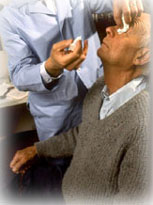How a Cataract is Detected
A thorough eye examination by your eye doctor can detect the presence and extent of a cataract, as well as any other conditions that may be causing blurred vision or discomfort.

A comprehensive eye examination
usually includes:
Visual acuity test: This eye chart test measures how well you see at various distances.
Pupil dilation: The pupil is widened with eye drops to allow your eye care professional to see more of the lens and retina and look for other eye problems.
Tonometry: This is a standard test to measure fluid pressure inside the eye. Increased pressure may be a sign of glaucoma.
Your eye doctor may also do other tests to learn more about the structure and health of your eye. There may be other reasons for visual loss in addition to the cataract, particularly problems involving the retina or optic nerve.
Treatment of Cataracts
How quickly a cataract develops varies among individuals, and may even vary between the two eyes. Most cataracts associated with the aging develop gradually over a period of years. Other cataracts, especially in younger people and people with diabetes, may progress rapidly over a few months and cause vision to worsen. It is not possible to predict exactly how fast cataracts will develop in any given person.
 There are no medications, exercises or optical devices that have been shown to prevent or cure cataracts. There is some evidence that a well balanced diet may slow the development of cataracts. Protection from excessive sunlight may help prevent or slow the progression of cataracts. Sunglasses that screen out ultraviolet (UV) light rays or regular eyeglasses with a clear, anti-UV coating offer this protection. There are no medications, exercises or optical devices that have been shown to prevent or cure cataracts. There is some evidence that a well balanced diet may slow the development of cataracts. Protection from excessive sunlight may help prevent or slow the progression of cataracts. Sunglasses that screen out ultraviolet (UV) light rays or regular eyeglasses with a clear, anti-UV coating offer this protection.
For an early cataract, vision may improve by a change in eyeglasses, magnifying lenses, or stronger lighting. If these measures don't help, surgery is the only effective treatment. This treatment involves removing the cloudy lens and replacing it with a substitute lens.
In most cases, the decision to proceed with cataract surgery occurs when vision loss interferes with your daily activities, such as driving, reading, or watching TV. You and your eye doctor can make that decision together. In most cases, waiting until you are ready to have cataract surgery will not harm your eye. If you decide on surgery, and you have cataracts in both eyes, the ophthalmologist will not remove them both at the same time. This is a precautionary practice which limits the potential surgical complication of an infection to one eye. You will need to have each done separately.
Sometimes a cataract should be removed if it prevents examination or treatment of another eye problem, such as diabetic retinopathy or age-related macular degeneration.
|